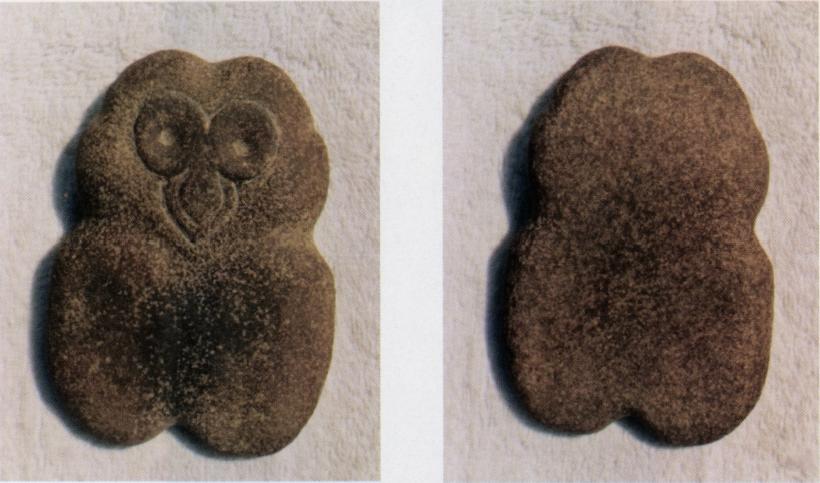by David A. Easterla, Ph.D., Maryville, Missouri
Originally Published in the Central States Archaeological Journal, Vol.56, No.4, pg.200Originally Published in the Central States Archaeological Journal, Vol.57, No.3, pg.128

Above: Front side of the Owl effigy medallion (tablet) the owl effigy medallion (tablet) from northwest Missouri.
Usually one-of-a-kind artifacts are difficult to interpret. Certainly this is the case for an owl effigy medallion (tablet) found by Harold V. Reed in Clear Creek approximately 1-2 miles east Clearmont, Nodaway County, Missouri, between the 1930’s and early 1980’s. During these early years Clear Creek was straightened by the Corp of Engineers and by chance this straightening went through a campsite of one of the meandering curves which resulted in a great number of artifacts being found, dating from Paleo to Mississippian. Unlike most streams in the area, Clear Creek is spring fed with very clear water, hence, a very desirable area for a campsite and human habitation.
The owl medallion is made from a very find red-grained quartzite. Although rare, this red fine-grained quartzite rock appears occasionally in hardstone artifacts in the four corner area of northwest Missouri, southwest Iowa, northeast Kansas, and southeast Nebraska (see Easterla, 2009, p. 121). The origin of this red quartzite is believed to be eastern Kansas.
The owl medallion measures 4 5/8″ long by 3 1/2″ wide. It is very symmetrical, shows peck marks, and is polished over much of the surface, especially around the eyes and bill. The facial region is very stylistic. Obviously the maker took great pride in creating the impressive eyes and bill. Based upon the large rounded “puffy” head, large eyes, and the lack of feather ear (horn) tufts, the depicted owl is probably the Barred Owl, which is a common permanent resident of the area woodlands today. The back side of the owl medallion shows only peck marks and lacks any markings/ figures (Fig. 2). Not only are owls a fascinating group of birds today by their secretive nocturnal habits, ability to turn their head about 360 degrees, etc.,but they obviously fascinated the Native Americans as documented by owl effigies appearing on pipes, bowls, etc. This owl medallion was probably Hopewellian, and was undoubtedly one of a kind for the clan/family tribe that created it. Unfortunately, we will never know the real meaning of such an effigy. Regardless, one would suspect this owl signified great mystical and ritualistic power to the Native Americans like we still find in certain remote tribal regions in some of the third world countries. In 1985 the author obtained this artifact from the finder who wanted to pass the artifact on for future study.”Used by Permission of the Author”
To learn more about or to join the Central States Archaeological Society, click here:CSASI.org
